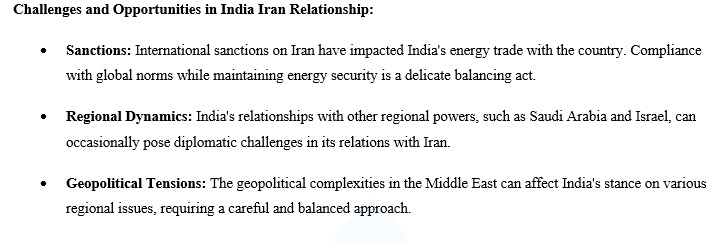PSIR 7c. What are the challenges and limitations in India - Iran relations UPSC 2023, 15 Marks
Both India and Iran have maintained diplomatic ties and are keen on expanding their cooperation in various fields, such as trade, energy, and regional stability. Their relationship remains dynamic and influenced by evolving regional and global dynamics.

Challenges and Limitations in India-Iran Relations
While India and Iran share historical and cultural ties, there are several challenges and limitations in their bilateral relationship:
1. International Sanctions:
Impact on Trade: Iran has faced extensive international sanctions, limiting its trade and economic interactions, including with India. These sanctions hinder India's energy imports and infrastructure projects in Iran.
2. Energy Dependence:
Reliance on Oil: India is heavily dependent on Iranian oil. The fluctuation in global oil prices and the Iranian sanctions can disrupt India's energy security.
3. Competition in the Region:
Regional Power Dynamics: Both India and Iran are major players in the region, and their interests often diverge. India's relations with Iran have been influenced by its ties with other regional actors, such as Saudi Arabia and Israel.
4. Chabahar Port:
Delays in Development: Despite strategic significance, the development of the Chabahar Port has faced delays, limiting its potential as an alternative trade route to Afghanistan and Central Asia.
5. Balancing Act:
Pressure from the U.S.: India has faced pressure from the United States to reduce its economic ties with Iran. This has forced India to navigate a delicate balance between its relations with Iran and its strategic partnership with the U.S.
6. Security Concerns:
Instability in Afghanistan: Both India and Iran are concerned about the situation in Afghanistan and its implications for regional security. Their interests may not always align on how to address this challenge.
7. Religious and Cultural Differences:
Sunni-Shia Divide: India has a predominantly Sunni Muslim population, while Iran is a Shia-majority country. The religious and cultural differences can sometimes strain bilateral relations.
8. Economic Constraints:
Resource Constraints: India's economic limitations can impede its ability to invest significantly in Iran or provide substantial financial assistance.
9. Competition for Influence:
Rivalries in the Region: India and Iran often compete for influence in countries like Afghanistan, which can strain their relations.
10. Geopolitical Tensions:
Global Geopolitics: Geopolitical tensions involving Iran, such as its nuclear program, can spill over into India's relations with the country.
11. Limited People-to-People Ties:
Lack of Cultural Exchanges: Compared to India's relations with some other countries, cultural and people-to-people ties with Iran are relatively limited.
12. Border Security Issues:
Balochistan Concerns: Iran has expressed concerns about Baloch separatist groups operating from Pakistani territory, which could affect bilateral security cooperation.
Despite these challenges and limitations, both India and Iran have maintained diplomatic ties and are keen on expanding their cooperation in various fields, such as trade, energy, and regional stability.
Their relationship remains dynamic and influenced by evolving regional and global dynamics.